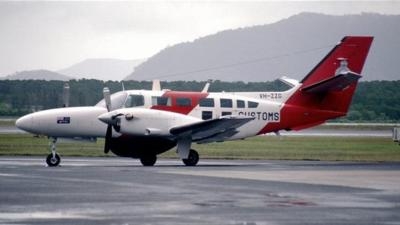Aircraft Was Conducting An Aerial Survey, Crew Suffered From 'Lack Of Situational Awareness
The Australian Transport Safety Board has released a report from an incident in which a pilot and crewmember aboard an Reims-Cessna F406 aircraft suffered from a lack of situational awareness due to oxygen deprivation during the flight, despite the use of oxygen on board the airplane.

According to the report, On 1 August 2014, at about 0935 EST, the aircraft departed Emerald, Queensland, on an aerial survey task. The crew consisted of a pilot and a navigator. The navigator was positioned in the cabin of the aircraft to operate survey equipment and direct the pilot according to survey requirements.
The aircraft was unpressurized, but fitted with an oxygen system to allow the crew to operate at altitudes above 10,000 ft. The crew planned to climb to FL240 for the survey task about to be undertaken. Prior to the flight, the pilot checked that there was adequate oxygen in the storage cylinder located in the nose area of the aircraft, and tested the oxygen system for normal operation.
The departure proceeded normally and, as the aircraft climbed through about 8,000 ft, the pilot turned on the aircraft oxygen supply and connected and donned his oxygen mask. This task involved connecting his oxygen system controller (which leads to the oxygen mask) to a port located beneath the pilot’s armrest. The task also required the pilot to remove his headset, transfer the microphone function from the headset to his oxygen mask, and place the headset back on (to allow continued receipt of communications through the headset ear cups). The pilot completed transition checks prior to passing 10,000 ft, which included confirmation that his oxygen system was in use and operating normally. The navigator also connected and donned his oxygen mask in the cabin of the aircraft during the climb.
The pilot also placed an oxygen pulse meter (supplied by the operator) on one of his fingers. As the aircraft continued to climb, the pilot monitored his blood oxygen saturation level readings on the oxygen pulse meter, and monitored his flow of oxygen by reference to a flow indication in the supply tube. The pilot recalled that everything appeared normal as the climb continued, but passing about FL 180, he noticed that his blood oxygen saturation level had fallen significantly.
The pilot recalled that although flow indications a appeared to remain satisfactory, his blood oxygen saturation level had fallen to about 77% - substantially less than what the pilot indicated he would normally expect (in excess of 90%).
As the climb continued, the pilot expressed concern to the navigator about his abnormally low blood oxygen saturation level. Based upon his knowledge from hypoxia awareness training, the navigator was aware that such an abnormally low blood oxygen saturation level meant that the pilot was probably experiencing the effects of hypoxia. Accordingly, the navigator encouraged the pilot to address the problem and increase his blood oxygen saturation level, and began to monitor the pilot’s condition.
Although the sequence of events is unclear, a number of things happened over the course of the
following several minutes which are broadly summarized as follows:
- The pilot initially attempted to increase the amount of oxygen he was receiving by making an adjustment to his oxygen system controller. He later identified a problem with his oxygen system connection, and spent some time handling the supply tubing and connections in an attempt to resolve the problem. Aware that the pilot was experiencing some difficulties with his oxygen supply, the navigator moved forward in the cabin to render assistance and to more closely monitor the actions of the pilot.
- Without an effective supply of oxygen, the accuracy with which the pilot was controlling the aircraft deteriorated. The navigator recalled encouraging the pilot to maintain control and to descend, a number of times. The pilot recalled losing situational awareness, and prompts from the navigator drawing his attention to the attitude of the aircraft.
- The navigator commented that the pilot failed to respond to some air traffic control (ATC) transmissions, and when he did respond, the responses were non-standard and his speech was slurred. ATC also noticed that the pilot was not responding normally, also noting that his radio transmissions were slurred. ATC encouraged the pilot to ensure that he was receiving a supply of oxygen by transmitting ‘oxygen oxygen oxygen’ and clearing the pilot to descend. Concerned about the safety of the aircraft, ATC also declared an ALERFA.
- Despite his apparently hypoxic condition, the pilot was ultimately able to identify that an oxygen supply system fitting had become disconnected. The fitting was located beneath the pilot’s armrest, and was the same fitting that the pilot had earlier connected during the climb. When he reconnected the fitting, he took a number of deep breaths and sensed almost immediate relief.
- At about the time the pilot appeared to be recovering from his hypoxic condition, the navigator recalled handing his oxygen pulse meter to the pilot, after the pilot indicated that his was not working correctly.
- The pilot commented that his confused state cleared quickly when the flow of oxygen was reestablished. He noticed at that point that the engines were still set to climb power. He reduced power and commenced a controlled descent. The navigator noted that the pilot’s speech became more coherent and standard radio phraseology returned soon after commencement of the controlled descent. Following the incident, the crew elected to return to Emerald. The pilot remained on oxygen throughout the remainder of the flight, including the arrival and landing at Emerald, which was uneventful. After landing, the pilot noted that his blood oxygen saturation level had increased back to a normal level (around 97%).

The entire flight lasted about 35 minutes. Available evidence suggests that the length of time from the first indication of a low blood oxygen saturation level to the point at which the pilot’s oxygen supply was re-established and a controlled descent commenced, was of the order of 10 minutes.
During most of this time, the aircraft was probably maneuvering between about FL 200 and FL 240. The maximum altitude reached was about FL 245.
As a result of this occurrence, the aircraft operator has taken steps in relation to pre-flight oxygen system checks, and crew cross-checks on the performance of each other’s oxygen system during flight above 10,000 ft.
The ATSB said that This incident highlights the importance of careful attention to aircraft oxygen systems, particularly with respect to connecting and monitoring oxygen system performance. An interruption in the supply of oxygen can quickly lead to hypoxia and crew incapacitation, particularly at higher altitudes. While the pilot was able to re-establish the flow of oxygen on this occasion and recover from his hypoxic condition, pilots are reminded that hypoxia is an insidious condition and the time of useful consciousness is often very limited. A prompt and decisive response to the first indication of an oxygen supply problem is imperative.
(ATSB Images. Airplane pictured in supplied photograph is representative and not the incident airplane)
 ANN's Daily Aero-Term (04.24.24): Runway Lead-in Light System
ANN's Daily Aero-Term (04.24.24): Runway Lead-in Light System ANN's Daily Aero-Linx (04.24.24)
ANN's Daily Aero-Linx (04.24.24) Aero-FAQ: Dave Juwel's Aviation Marketing Stories -- ITBOA BNITBOB
Aero-FAQ: Dave Juwel's Aviation Marketing Stories -- ITBOA BNITBOB Classic Aero-TV: Best Seat in The House -- 'Inside' The AeroShell Aerobatic Team
Classic Aero-TV: Best Seat in The House -- 'Inside' The AeroShell Aerobatic Team Airborne Affordable Flyers 04.18.24: CarbonCub UL, Fisher, Affordable Flyer Expo
Airborne Affordable Flyers 04.18.24: CarbonCub UL, Fisher, Affordable Flyer Expo




